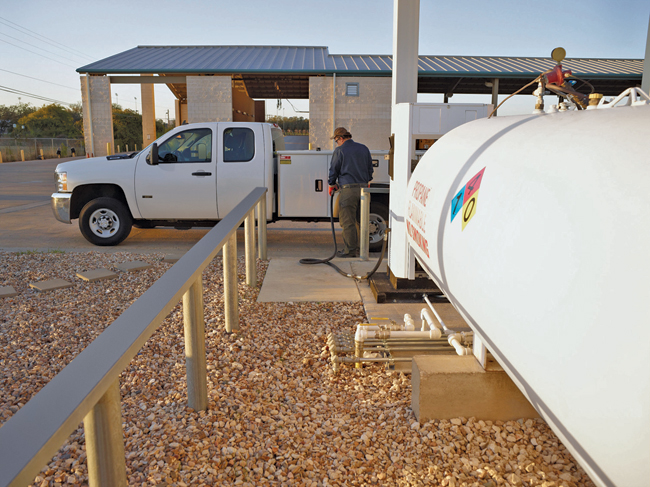Are Alternative Fuels a Pain at the Pump?
With demand growing for alternative fuel choices, curious and progressive contractors are exploring the market. Both construction equipment and truck manufacturers are releasing more and more products focused on alternative fuels (biodiesel, bioalcohol, electricity, natural gas and even vegetable oil). Propane autogas is just such an alternative fuel, and fleets across the country are adding work trucks fueled by propane autogas to haul equipment and workers. Most users cite the cost-effectiveness, high performance and great PR that comes with using propane autogas in work trucks — but an often overlooked attribute is easy refueling.

Propane providers work with fleets to develop a strategic refueling approach that best meets a fleet’s specific needs and requirements. On-site propane autogas dispensing systems, which include a large tank and a no-spill dispenser, are compact and easily installed in a central location. This makes refueling convenient for some fleets by eliminating off-site trips for drivers. A variety of tank sizes and dispensing pumps are available. On-site dispensing also can be upgraded as a fleet grows.
Propane providers make it easy to install on-site refueling. They inform fleet managers about the advantages of both owning and leasing infrastructure, allowing them to make an informed decision. They also work with local municipalities and states to ensure the appropriate infrastructure is installed and that it meets local and state regulations. Installation cost for an on-site propane autogas dispensing system is comparable to the cost of installing a gasoline or diesel station. Initial installation work may only take a few weeks, depending on the infrastructure type.
Safety Training Options for Fleets
Once the dispensing station is installed, propane providers can provide training to owners, managers and drivers on proper safety procedures. They also instruct a fleet’s on-site trainers on proper personal protective equipment (PPE) and share safety materials. Propane providers help to ensure compliance is established and enforced by federal, state and local authorities. Vehicle refueling is a straightforward process for fleet managers and operators who use appropriate refueling techniques and follow safety procedures. The Propane Education & Research Council (PERC) advises vehicle operators to follow these six refueling steps:
1. Ensure proper protection. Always wear appropriate personal protective equipment (PPE), like gloves and eyewear, inspect the propane autogas fuel tank to ensure it is in proper working condition and make sure the ignition is off.
2. Prepare and connect. Set the propane autogas meter to zero and connect the motor fuel hose to the tank valve.
3. Begin refueling. Start the fuel pump and slowly open the valve at the end of the hose.
4. Finish refueling. When the overfill protection device stops the fuel flow, immediately close the valve on the end of the hose and shut off the fuel pump.
5. Disconnect from the tank. Slowly loosen the filler adapter and wait until propane autogas stops venting before completely disconnecting the adapter.
6. Fuel inspection. Check the valve for leaks and replace the dust cap.
These steps should not be considered as a substitute for safety training courses offered by a propane provider. All propane autogas vehicle fuel tanks should be labeled based on American Society of Mechanical Engineers (ASME) standards, listing the working pressure and other tank information. A propane decal must be displayed on the lower right rear of the vehicle, near the bumper, to alert emergency responders that propane autogas is present.
For more information on propane autogas refueling procedures and safety training, get in touch with your local propane provider or visit PERC’s website at www.autogasusa.org.
Stuart Flatow is the vice president of safety and training at the Propane Education & Research Council, based in Washington, D.C.
